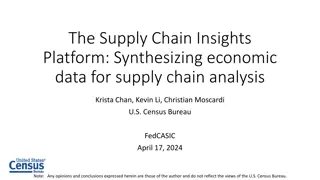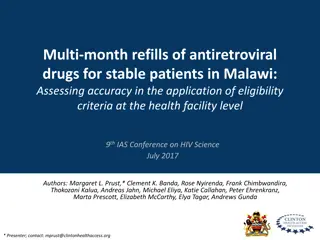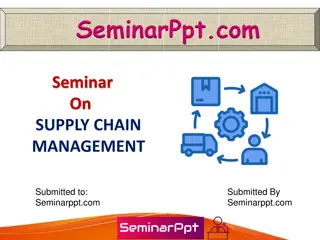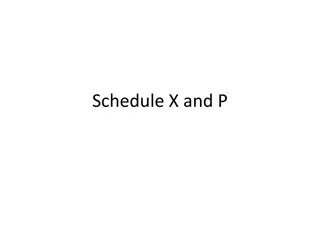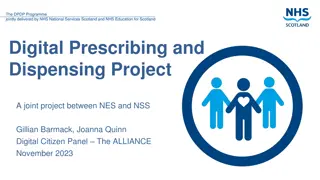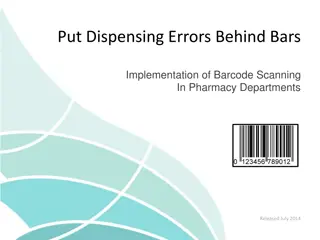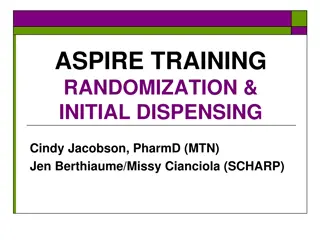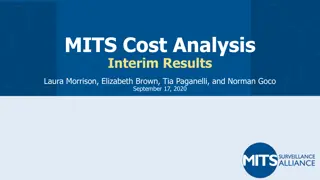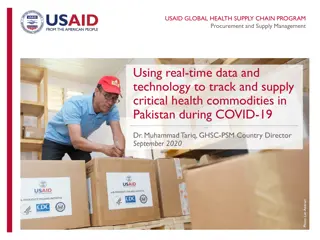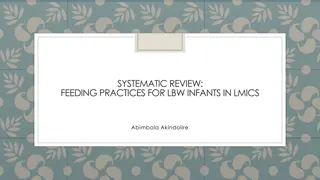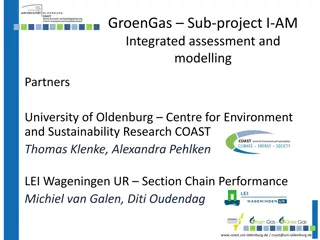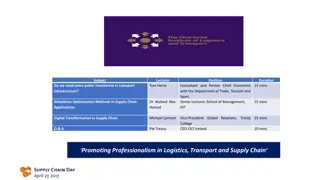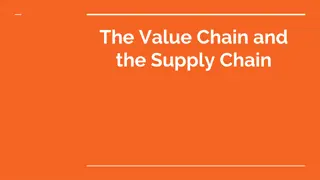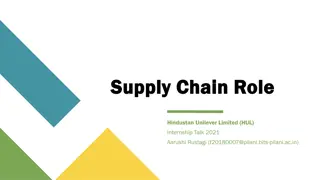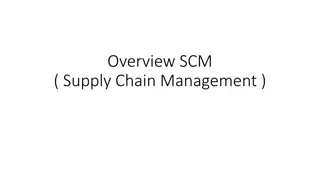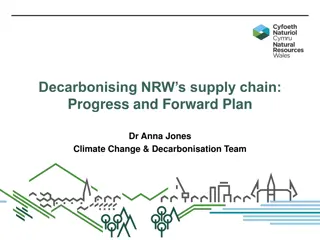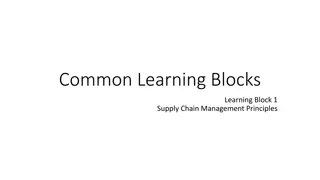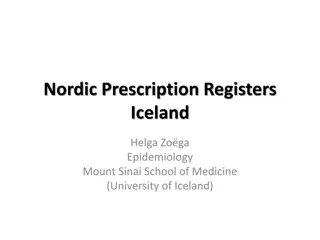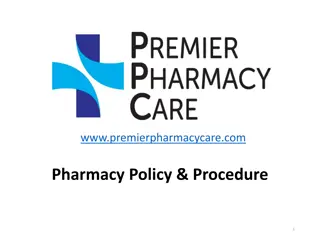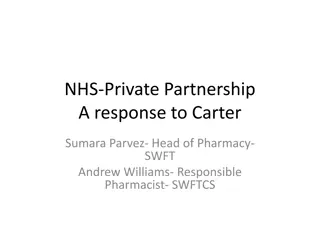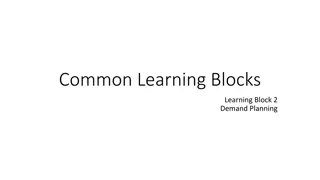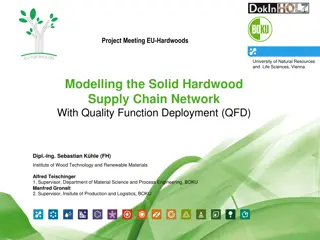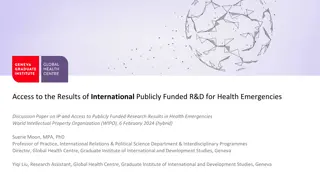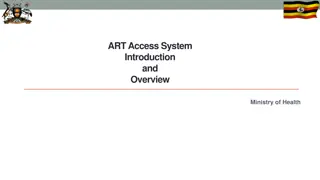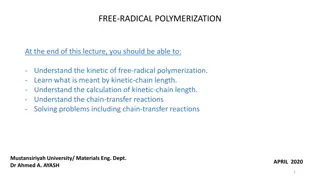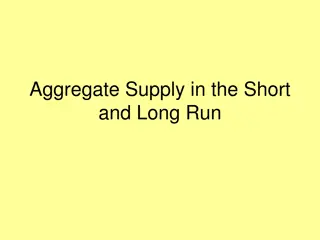Accelerating Multi-Month Dispensing for ART in LMICs: Supply Chain Insights
This content discusses the utilization of supply chain constraint analyses to expedite Multi-Month Dispensing (MMD) for ART during COVID-19 in Low- and Middle-Income Countries (LMICs). It explores the stock impact and consequences of implementing MMD3 or MMD6, scenarios of moving patients to MMD6 immediately or phased, and the insights provided by the Multi-Month Simulation (MuMS) tool. Decision-makers are advised to evaluate risks of stockouts and consider phased transitions. The limitations of MuMS in managing consumption and shipment changes in a complex implementation environment are also highlighted.
Download Presentation

Please find below an Image/Link to download the presentation.
The content on the website is provided AS IS for your information and personal use only. It may not be sold, licensed, or shared on other websites without obtaining consent from the author. Download presentation by click this link. If you encounter any issues during the download, it is possible that the publisher has removed the file from their server.
E N D
Presentation Transcript
USAID GLOBAL HEALTH SUPPLY CHAIN PROGRAM Procurement and Supply Management Is there sufficient stock to implement multi-month dispensing (MMD)? Using supply chain constraint analyses to accelerate MMD for ART during COVID-19 in LMICs Photo: GHSC-PSM presented at the 2020 Health and Humanitarian Logistics Conference
The Essential Question Given a) b) c) What's the stock impact of providing or expanding MMD3 or MMD6 to patients (in an immediate or phased manner)? the forecasted consumption stock on hand, and incoming shipments USAID GLOBAL HEALTH SUPPLY CHAIN PROGRAM-Procurement and Supply Management 2
Applying the Multi-Month Simulation (MuMS) tool to a real country If this is what the current months of stock looks like, what are the consequences of moving all 1st line ARV patients to MMD 6 immediately (scenario A)? What happens if we phase in MMD6 (scenario B)? USAID GLOBAL HEALTH SUPPLY CHAIN PROGRAM-Procurement and Supply Management 3
What does the Multi-Month Simulation (MuMS) tool tell us? Scenario A shows an immediate drop below the minimum number of months from Jul-Nov 2020 Scenario B also shows a drop below min, but it is less significant Decision-makers should consider if the dip below minimum is too high a risk of stockouts at some locations, but no national stockout will occur USAID GLOBAL HEALTH SUPPLY CHAIN PROGRAM-Procurement and Supply Management 4
What else can MuMS tell us? And we model incoming shipments as only 75% of the quantities ordered for TLD90: If keep Scenario B as a phased transition: Scenario C: Scenario B: TLD90 Scenario C: TLD90 USAID GLOBAL HEALTH SUPPLY CHAIN PROGRAM-Procurement and Supply Management 5
Why is MuMS limited to changes in consumption and changes in shipments? Consider the complexity of the environment in which these changes are being implemented. For the sample country here s where things stood at the end of testing the tool: MMD3: Implementation complete MMD6: Implementation in Progress 5% on monthly = mostly new patients 20+% on MMD6 Implementation Guidelines developed Supply - MOH procures (PEPFAR-supplied booster) Implementation Guidelines developed Implementing with both TLD30 and TLD90 Big increase in patient issues ~June 2020, due to increased community distribution of medicines to avoid clinic visits Challenges Risk: Supply Availability Government stock slow, tender only for TLD30 (Supplier agreed to supply a portion as 90, but need more). TLD90 stock issues (Apr-Jun 2020) Risk: Exchange rate fluctuations impact budget Information Systems & Data User and system challenges hindering accurate MMD6 reporting. The clinical management information system, may be under-reporting USAID GLOBAL HEALTH SUPPLY CHAIN PROGRAM-Procurement and Supply Management 6
What does MuMS need as inputs? 1. PipeLine Database 2. Start Month 3. Patient # by Regimen (drug, bottle size, MMD) 4. Select options for scenarios Immediate: All patients start in month 1 Phased: Patients transition over 3-6 months USAID GLOBAL HEALTH SUPPLY CHAIN PROGRAM-Procurement and Supply Management
What does MuMS produce as outputs? Patient splits across MMD Overall Stock Status for first Line ARVs Stock Status graphs for each commodity Stock Status table for each commodity, highlighting stock issues & stockouts USAID GLOBAL HEALTH SUPPLY CHAIN PROGRAM-Procurement and Supply Management
User Feedback MuMS will help guide discussions around stock requirements for multi-month ART dispensing scale up. It will make it quite easy for the logistics teams to quickly review projected consumption and supply plans to accommodate various levels of multi-month scripting while ensuring optimal stock levels moving forward. a GHSC-PSM MuMS field tester USAID GLOBAL HEALTH SUPPLY CHAIN PROGRAM-Procurement and Supply Management 9
Might we need MuMS in the future? MuMS was created to help during COVID, but can be used to transition between any two products and changes to multi-month packs: How many of Product A will be in the market when Product B is introduced? How long will current stock last? How many bottles of Product A are still in warehouses/in production? How many months of future demand will that supply? When will Product B need to arrive to replace Product A, without affecting the Product A demand? Consider use of MuMS for optimization of pediatric formulations. USAID GLOBAL HEALTH SUPPLY CHAIN PROGRAM-Procurement and Supply Management 10
Conclusions MuMS helps programs determine if the supply of commodities will be a constraint in the implementation of MMD. The Excel- based tool requires stock on hand, consumption, and planned shipment data from the Pipeline software and models changes in consumption, shipment timing, and shipment quantity, to determine the consequences of implementing MMD. USAID GLOBAL HEALTH SUPPLY CHAIN PROGRAM-Procurement and Supply Management 11
Barry Chovitz Technical Director, Leadership & Governance, Health Systems Strengthening Team bchovitz@ghsc-psm.org The USAID Global Health Supply Chain Program-Procurement and Supply Management (GHSC-PSM) project is funded under USAID Contract No. AID-OAA-I-15-0004. GHSC-PSM connects technical solutions and proven commercial processes to promote efficient and cost-effective health supply chains worldwide. Our goal is to ensure uninterrupted supplies of health commodities to save lives and create a healthier future for all. The project purchases and delivers health commodities, offers comprehensive technical assistance to strengthen national supply chain systems, and provides global supply chain leadership. For more information, visit ghsupplychain.org. The views expressed in this presentation do not necessarily reflect the views of USAID or the U.S. government. USAID GLOBAL HEALTH SUPPLY CHAIN PROGRAM-Procurement and Supply Management




